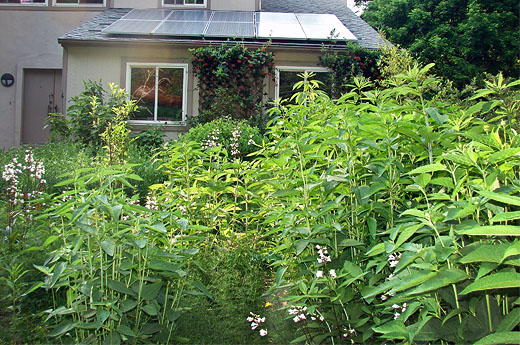
by guest blogger Maya K. van Rossum, the Delaware Riverkeeper
The natural world is awakening from a tough winter, and our yards are greening up as the weather warms.
But are our yards really as “green” as they could be?
Across the country, as communities have expanded and new developments have been built, the amount of land covered with a green grass carpet has grown. We’ve lost the native vegetation—trees and shrubs in particular—that should characterize our landscapes.
And as this vegetation disappears, we’ve seen floodwaters rising, stream banks eroding, drinking wells running dry, and overall water quality declining. There is a direct connection between the loss of native vegetation in our communities and what’s happening to our local streams and rivers.
When vegetated with native trees and shrubs and covered in a blanket of decaying leaves, conifer needles, and wood, the land acts as a sponge. Rainwater percolates into the soil, filtering down to the water table below to resupply the aquifers that provide our drinking water. Rainwater also provides base flow to our streams, creeks, and rivers. The landscape, in this natural state, is alive with life—birds sing in the trees, squirrels dance across the ground, bugs revel in the earth. Our water flows free and clean.
Not all vegetation is created equal, however. Lands vegetated only by grass cannot perform the functions of the natural landscape. Lawns don’t act as sponges. Lawn mowers and heavy foot traffic cause soil compaction, which limits water infiltration. Lawns established as part of a development have soils compacted intentionally for site engineering and construction purposes. As a result, lawns more closely resemble impervious surfaces, such as sidewalks or roadways.
Consequently, lawns generate significantly more stormwater runoff than meadows, scrub vegetation, or forests. What’s more, runoff from our lawns is often carrying excess or improperly applied fertilizers and pesticides. This runoff is channeled to nearby storm drains, which move it through storm sewers to a local creek, where it combines with runoff from other upstream communities.
Our stream channels are being scoured by fast-moving stormwater, and our stream banks are being eroded. The eroded sediments turn our streams a chocolate brown, depriving fish and plants of light. When the sediment settles out of the water column, it smothers the streambed, where aquatic insects live and fish lay their eggs.
Downstream communities are now suffering the effects, experiencing higher and more frequent flooding. They’re bearing the brunt of the loss of vegetation. And as part of their standard vegetation-clearing plans, both upstream and downstream communities clear the very stream banks and floodplains that could otherwise serve as part of a protective solution.
As they are presently constructed, stormwater detention basins do little to alleviate problems associated with runoff. They can, in fact, make problems worse. These basins serve only to reduce peak flows of stormwater runoff, and they ultimately prolong the harmful impacts of a storm event on our streams and on downstream communities.
Planting our stream corridors with trees and shrubs could moderate the effects of increased stormwater runoff.
We can also have an impact with the way we manage our own lands, public and private. Many of us enjoy a grassy area in our yards, a place to play, sunbathe, or read. We can continue to enjoy our spot in the sun even as we reduce the total amount of lawn we maintain.
Start by re-vegetating little-used grassy areas. Plant native plants; add a garden; consider adding a perimeter of native trees and shrubs. Doing so not only benefits us directly—it increases the value of our homes by beautifying our gardens, providing shading to cool homes in the warm summer months, and adding a visual and noise buffer that can enhance our quality of life—but it also provides flood and pollution prevention and protection to our downstream neighbors.
For those of us who have streams in our yards, it is vitally important that we take on the added obligation of protecting and/or putting in place wide vegetated buffers filled with native trees, shrubs, and plants that will prevent streamside erosion, help reduce flood flows and peaks, and help filter out water pollution.
Through simple landscaping practices we can improve local water quality, contribute to flood relief for downstream communities, provide habitat for birds and wildlife, and bring privacy and peace to our own backyards while still allowing for the lawns many people so love to mow.
 Maya K. van Rossum is the Delaware Riverkeeper, and has led the Delaware Riverkeeper Network (DRN) since 1994. The DRN is a regional nonprofit advocacy organization that monitors the river and all of its tributaries for threats and challenges, and advocates, educates, and litigates for protection, restoration, and change.
Maya K. van Rossum is the Delaware Riverkeeper, and has led the Delaware Riverkeeper Network (DRN) since 1994. The DRN is a regional nonprofit advocacy organization that monitors the river and all of its tributaries for threats and challenges, and advocates, educates, and litigates for protection, restoration, and change.




I am SO deeply grateful that there are people like you, Maya, who spend their lives working to save our earth! And us! Thank you for all this information and for all you are doing for all of us and especially for our wonderful home – earth. More than anything in this world, I want my Goddaughter to have a future to enjoy!
I gave a lecture a few weeks ago to a local chapter of the Native Plant Society of Texas, and spoke many of the same words. I also sit on a local watershed advisory board that is dealing with these issues now. It is extremely difficult to get people on board in order to save our lakes and rivers. Many of these boards and committees are made up of developers and engineers (hired by the developers) that it is impossible to get a “green” agenda passed. We must educate one home at a time so that the community demands a better alternative than concrete detention ponds and close cut lawns. Tomorrow I speak to the Men’s Garden club on drought. Oddly enough, the same truths about “greening” the landscapes apply to solving drought problems. Keep up the good work.